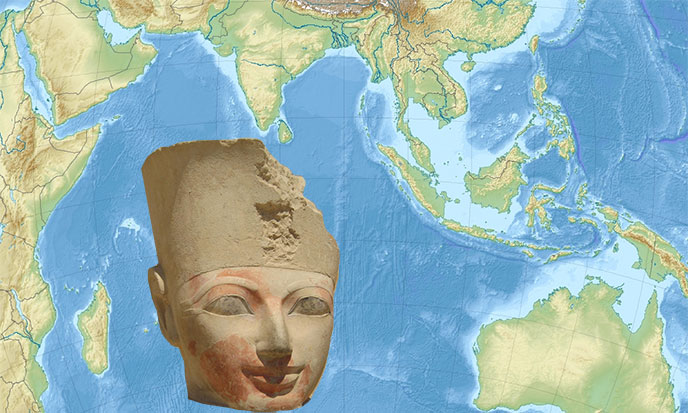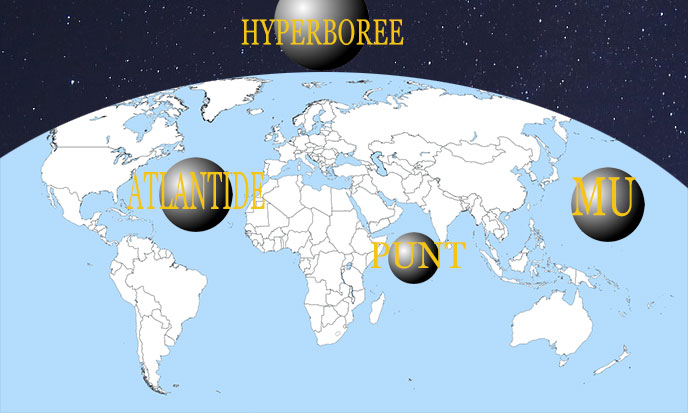
Egyptian annals mention numerous trade with a land that our historians struggle to localize: the Land of Punt. The thing is not exceptional: many countries have changed their names as wars of conquest. But there are still too many quirks around the famous Land of Punt.
The Land of Punt, or Pwenet and Pwene, also called Ta Netjer, which means Land of God, is a commercial site that appears in the stories of ancient Egypt, the location of which is still uncertain.
Most authors are now the site on the African coast of the Red Sea, from Eritrean-Sudanese border north of the current Somalia. Others suggested a location either side of the Red Sea including the southern Arabian Peninsula, other rarer designate the Levant. (source)Wikipedia
In short, nobody really knows where it was, and, most curious thing, the mysterious Land of Punt appears without warning around 2500 BCE and disappear as suddenly around 1000 BCE.
Still, a country does not disappear like dust under the carpet. No, but a country can always change the name. Or change location. Yes, disappear here to be found elsewhere. Because there are more singular. See detail.
“The oldest expedition to Punt where we record dates back to Sahu pharaoh of the Fifth Dynasty, around 2500 BCE. The scenes published by Tarek el Hawady show the king Sahu sitting at the incense trees planted visibly in Egypt, or standing equipped with an adze and preparing to cut the bark to make resin flow.
At the end of the Old Kingdom (Sixth Dynasty) an assignment mentioned Punt. Thus Herkhuf reproduced at the entrance to the tomb of the king Neferkare a letter mentioning a dwarf brought from Punt to Egypt during the reign of Djedkare Isesi (Fifth Dynasty) by the dignitary Ourdjededba.” (source)Wikipedia
The presence and influence of Punt continue and even amplify during the Middle Kingdom. In the New Kingdom, the Land of Punt, still unable to locate, has become the source of all the mythical treasures, manufactured objects, unknown animals and plants to the wonderful virtues, like incense that Africa just discovered. And in this context, we will find our old friend the queen-king Hatshepsut.
“An expedition remained famous is that of Nehesy, a senior official at the orders of Queen Hatshepsut, around 1500 BCE. Nehesy fetched myrrh, frankincense, gold, leopard skins, thrown weapons and cuttings d ‘incense trees. These trees were replanted on the driveway of the funerary temple of the queen, at Deir el-Bahari.
This trip was so important that was preserved on the walls of the north portico of the second terrace of the temple. Several successors of Queen Hatshepsut, Thutmose III which, had contacts with Punt.” (source)Wikipedia
It seems obvious to me that Puntis and Punt sovereigns played a leading role in the regency and the reign of Hatshepsut.
Thanks to them, Hatshepsut had access to an awakening technology it could have obtained otherwise. It owes his foresight, his power and wisdom. In the Middle East, which is torn by internal wars, Punt is definitely not a country like others.
“Note the story of the journey to the Twentieth Dynasty, during the reign of Ramses III recorded in the papyrus Harris I, from 77.8 to 78.1 lines where are evoked the” mysterious wonders “and myrrh brought from that country. This trip took place before the year 22 of the reign of Ramses III as Pierre Grandet.
The king called the pountites products offered to its Amon temple of Medinet Habu as “the most outstanding products” This is gum, myrrh, red pigment and “good fragrant grass.” (source)Wikipedia
This is more remarkable handicrafts too, such as perpetual lamps, electric batteries, observation instruments (glasses or telescopes), navigation instruments like Antikythera computer, and other wonders yet.
And then suddenly, around 1000 BCE, trade stop short. After which the Punt disappears memories, he became a legend while its exact location has already lost.
In the funerary temple of Queen Hatshepsut at Deir el-Bahri, a “block has a navigation stage with exotic animals in the company of people of Punt.”
Exotic animals? My gut tells me that these lemurs. These lovely animals are the source of a curious case. They are found in two distinct areas of the globe: in Madagascar on the one hand and Malaysia on the other.
Lemurs, which some biologists have identified as our possible ancestors, are alien animals? Will he had Homo lemurianis, missing link between us and them?
The famous skull of Sealand, is if it is not a crude forgery, could be an acceptable candidate. The huge eyes of lemur are present home.
This geographical anomaly has intrigued a researcher in the 19th century. The British zoologist Philip Sclater was unable to explain the presence of lemurs in Madagascar as in Malaysia.
He hypothesized a continent engulfed by the Indian Ocean that would have served as a bridge by which would have passed these graceful animals.
This continent, naturally, he called Lemuria.
The German naturalist Ernst Haeckel approved: the distribution of lemurs accredits the existence of a continent in the Indian Ocean. (source)Wikipedia
Sailing to the Land of Punt
Oops, the same as that posed by Atlantis: no trace of a sunken continent in the Indian Ocean. Moreover, the presence of a back underwater totally forbidden this hypothesis.
So what? The same causes produce the same effects, don’t they? The reasoning that applies to Atlantis so well may apply in the Indian Ocean as well. Imagine a giant spherical spaceship, about 3000 km diameter. It landed on the Atlantic Ocean. They named it the island of Atlantis, and it made a perfect transition from one continent to another.
Just think about! A 3000 km ship-island would leave only a few hundred kilometers of ocean to reach the shore on either side. This is quite consistent with the description of Plato.

Why not imagine the same scenario in the Indian Ocean? A ship-island called Punt, arose around 4500 BP and meets at the same time in East Africa, southern India and Malaysia.
One day there 3000 years, he left the Indian Ocean to regain the stars from which he came. Exit Punt.
I have explained how the aliens terraformers colonized primitive peoples of earth. The giant islands-vessels were a major part of their strategy. Around the island of Atlantis, the coasts of America, Europe and Africa have experienced commercial, cultural, technical and scientific improvement. Around Punt, the same improvement happened on the nearest African and Asian coasts. Around the space-island Mu in the Pacific Ocean, the same development took place on the banks of the South East Asia and Andean America. Note that the word comes from the Greek ponthos Punt, meaning sea.
Punt therefore means the Country of the Sea. Now it gets clear. Especially as the Greek word ponthos did not give sea or ocean in French. It gave the word bridge, which a singular way of naming a sea. Unless in the midst of this sea, there is a fairly large artificial island to serve as a bridge linking two continents.
Finally, remember what other name was once gave this famous Land of Punt:
Ta Netjer, meaning god’s country.
It could not be clearer. Land of Punt was a divine counter in the Indian Ocean.
Before closing this page, I must say that another mysterious country, Dilmun, abundantly quoted in Sumerian mythical literature, seems to me to be the same as Punt. It has the same characteristics, it is located in the same part of the world, somewhere between the Persian Gulf and the Indian Ocean, and is also the Land of the Gods …


